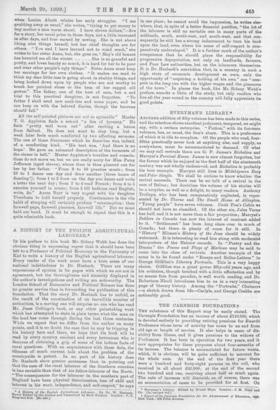EVERYMAN'S LIBRARY.*
ANOTHER addition of fifty volumes has been made to this series, and the selection shows excellent judgment, tempered, we might say, with a certain enterprise. "Fiction," with its fourteen volumes, has, as usual, the lion's share. This is a preference of which it is idle to complain. Of the people who read, four- fifths practically never look at anything else, and supply, as evei:ywhere, must be accommodated to demand. Of what we may call revivals there are G. P. James's _Richelieu and Marryat's Percival Keene. James is now almost forgotten, but the favour which he enjoyed in the first half of the nineteenth century was not wholly undeserved, and Richelieu is probably his hest example. Manyat still lives in Midshipman Easy and Peter 'Simple. We shall be curious to know whether the revival succeeds. There can be no talk of a revival in the case of Balzac; but doubtless the volume of his stories will be a surprise, as well as a delight, to many readers. Anthony Trollope, who has been comparatively neglected, is repre- sented by Dr. Thorne and The Small House at Allington. "Young people" have seven volumes. Uncle Tom's Cabin ws should not have so classified. Of the other six, Jules Verne has half, and it is not more than a fair proportion; Marryat's Settlers in Canada has now the interest of contrast added to it. "Settlement" has been long since over in much of Canada; but there is plenty of room for it still. In " History " Milman's History of the Jews should be widely welcomed. It is interesting to read him along with modernist interpreters of the Hebrew records. In "Poetry and the Drama" the Poems and Plays of Marlowe may be said to come into the class of revivals. Another example of the same is to be found under "Essays and Belles-Lettres " in George Gilfillan's Literary Portraits. This is a very happy choice. Gilfillan was a great power fifty-odd years ago, and his criticism, though touched with a little affeotation and by no means free from paradox, is well worth reading, and Dr. Robertson Nicoll introduces him to us in a very interesting page of literary history. Among the "Portraits," Chalmers —a sketch drawn from life—Carlyle, and George Crabbe are noticeably good.










































 Previous page
Previous page